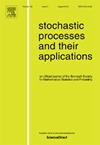某些流行病传播模型的对偶性
IF 1.2
2区 数学
Q3 STATISTICS & PROBABILITY
引用次数: 0
摘要
我们研究了三维非保守相互作用粒子系统中边界的作用和非平凡对偶函数的结构,这些系统可以模拟流行病的传播:(i)扩散接触过程(DCP), (ii)我们引入并称为广义扩散接触过程(GDCP)的模型,两者都是在有限体积内与边界水库接触,即开放边界,以及(iii) z上的易感-感染-恢复(SIR)模型。我们通过分析方法建立了每个系统的对偶关系。结果表明,在开放边界下,自对偶性被打破,与封闭边界(即没有储层的有限体积)相比,出现了质的不同:DCP和GDCP都是遍历的,但不再吸收,而各自的对偶过程是吸收的,但不是遍历的。我们用对偶吸收概率给出了平稳相关函数的表达式。我们对小尺寸的DCP进行了显式计算,并对GDCP的特定设置中的任意尺寸进行了显式计算。对DCP和GDCP的对偶函数进行因式分解,与SIR模型相反,SIR模型的对偶关系是非局部的,并且产生了一些特定相关函数的时间演化的显式表达式,描述了易感个体簇大小的时间衰减。本文章由计算机程序翻译,如有差异,请以英文原文为准。
Duality for some models of epidemic spreading
We examine the role of boundaries and the structure of nontrivial duality functions for three non-conservative interacting particle systems in one dimension that model epidemic spreading: (i) the diffusive contact process (DCP), (ii) a model that we introduce and call generalized diffusive contact process (GDCP), both in finite volume in contact with boundary reservoirs, i.e., with open boundaries, and (iii) the susceptible–infectious–recovered (SIR) model on . We establish duality relations for each system through an analytical approach. It turns out that with open boundaries self-duality breaks down and qualitatively different properties compared to closed boundaries (i.e., finite volume without reservoirs) arise: Both the DCP and GDCP are ergodic but no longer absorbing, while the respective dual processes are absorbing but not ergodic. We provide expressions for the stationary correlation functions in terms of the dual absorption probabilities. We perform explicit computations for a small sized DCP, and for arbitrary size in a particular setting of the GDCP. The duality function is factorized for the DCP and GDCP, contrary to the SIR model for which the duality relation is nonlocal and yields an explicit expression of the time evolution of some specific correlation functions, describing the time decay of the sizes of clusters of susceptible individuals.
求助全文
通过发布文献求助,成功后即可免费获取论文全文。
去求助
来源期刊

Stochastic Processes and their Applications
数学-统计学与概率论
CiteScore
2.90
自引率
7.10%
发文量
180
审稿时长
23.6 weeks
期刊介绍:
Stochastic Processes and their Applications publishes papers on the theory and applications of stochastic processes. It is concerned with concepts and techniques, and is oriented towards a broad spectrum of mathematical, scientific and engineering interests.
Characterization, structural properties, inference and control of stochastic processes are covered. The journal is exacting and scholarly in its standards. Every effort is made to promote innovation, vitality, and communication between disciplines. All papers are refereed.
 求助内容:
求助内容: 应助结果提醒方式:
应助结果提醒方式:


